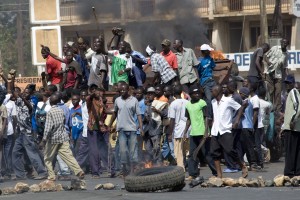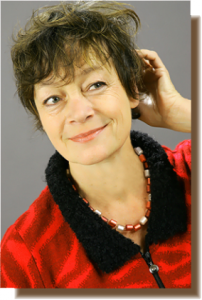Tips for training conflict sensitive reporting

Yasuyoshi Chiba/AFP/Getty Image
From Rwanda and Iraq to Kosovo and Cambodia, media around the world has often played a role in stirring up conflicts – whether deliberately or unwittingly. Teaching journalists conflict sensitive reporting is one way of helping to reduce potential hostilities and create the conditions for peace. Journalist and media trainer Kerstin Kilanowski talks to onMedia about her experiences of teaching conflict sensitive reporting.
The stages of conflict
Many countries have experienced some kind of conflict or even heavy violence so many journalists are well aware of what conflict actually is. What is important, though, is for them to learn about how conflicts start, which means being aware of the initial situation before hostilities actually flare up.
I also make sure I don’t use examples from the participants’ own countries when analyzing conflicts because this often triggers debates and arguments about who is to blame for a certain situation. Rather than discussing rights and wrongs, the participants should analyze and understand the structure and development of a conflict.
Uncovering your own prejudices
Something else that works very well, which I have developed from diversity training, is to get participants to name groups in their societies which are marginalized, such as ethnic minorities, sexual minorities, a certain caste, single mothers, prostitutes, widows, whatever. I collect all of these groups and I then ask each participant which of the groups they have the most problem dealing with. And they might say, “well, it’s the prostitutes”. Others might say, “it’s the sexual minority”. I then use those groups with the most negatives for a role play.
In the role play, one person is the prosecutor and another the defender in a public court. By doing the role play and defending a group that they really don’t like, the journalists have to enter into the mind of these marginalized people, which forces them to change their perspective. On the other hand, the prosecutors are allowed to express their prejudices which are often shared by others in the workshop. I think it is very important to put these prejudices out on the table. If you don’t allow people to talk about their biases, then they remain hidden.
The power of words
It is also important to show the power of language and how journalists can manipulate readers or listeners in a certain direction, for example, by reporting on a social group or an ethnic group in a certain way. In some cases, journalists might deliberately use inflammatory language, or hate speech. The best known example of this is in Rwanda, where private radio station Radio Television Libre des Mille Collines played a key role in inciting ethnic Hutus to kill Tutsis and inflamming the genocide.
In other cases, the manipulation might be subtle and unwitting but it is still present. To make the journalists aware of these issues, I hand out real articles that have been published, again not from the particular country, and I ask them to analyze the language of the articles. I have different examples, let’s say about an ethnic group in Indonesia or single mothers in Bangladesh. They are just small articles where the journalists can see for themselves what kinds of biases slip into the media and how they work.
Don’t accept information without question
It depends how much time you have in the training, but another element I find works well is to have the participants do another role play where they conduct interviews using set scenarios. For example, the scenario could be about a thief stealing something at the local market. One journalist might interview the policeman, the other interviews the market women who were witnesses, and another interviews a woman assumed to be involved in the crime. Unbeknownst to the journalists, I have given the interviewees secret instructions about what kind of attitude they should have, such as the suspicious policeman or the understanding neighbor. And usually, you find even experienced journalists fall into traps. Because, for example, the policeman might say that the thief came from a certain ethnic group or the market women say the thief was a prostitute and the interviewer never questions whether this is true or even relevant. It might just be that the policeman is racist or that the woman is an unmarried mother, and the market women think of her as a prostitute because of this.
The point is for the journalists to understand that not only have they inbuilt biases, but that people they are interviewing are also biased or have an agenda. In the end, the journalists are really flabbergasted that they fall into so many traps.
But again, it is very important not to chose a conflict or a group of people that are specific to the background of that country. For example, in Egypt, I wouldn’t get someone to pretend to be someone from the Muslim Brotherhood as you get caught up in the pros and contras which isn’t the point. Rather, the point is to sensitize the participants to the biases and prejudices of others.
Facing your own prejudices
If possible, the journalists can then do real interviews with the people they have problems with. Once at a training I held in Berlin, most of those in the group had an issue with sexual minorities. Coincidentally, there was a big HIV/Aids conference on the time and there were many gay and lesbian people attending, including even gay pastors and gay imams. So I arranged for the workshop participants to conduct interviews. They used their new knowledge to be polite and be neutral. At the end of this particular workshop, the participants said this part of the training was incredibly revealing and a mind-changing experience.
Useful resources
I also use material from Ron Howard’s fantastic Handbook for Conflict Sensitive Journalism in my trainings. It is very comprehensive and is available for free in the Internet.
Rome wasn’t built in a day
Of course, if you only do a five day training, you can’t expect to change the world in that time. The most you can hope for is to change the journalists’ mindset, to sensitize them to these subtle unwitting biases that can feed the tension within a society. You can’t prove that someone’s mindset has changed for good either. But I have often had a feeling at the end of a workshop that the journalists understand at least what the issue is.
 Kerstin Kilanowski lives in Germany and has been working as a freelancer for German national radio stations and print media since the 80s. She focuses on human rights, development cooperation, gender equality, social minorities and migration and refugee issues. In addition to her journalistic activities, Kerstin conducts training on intercultural communication and gender equality and gives workshops on dealing with social diversity for NGOs and international companies. For DW Akademie, she visits partner organization all over the world, giving media trainings to journalists. Kerstin has received several awards for her journalistic work.
Kerstin Kilanowski lives in Germany and has been working as a freelancer for German national radio stations and print media since the 80s. She focuses on human rights, development cooperation, gender equality, social minorities and migration and refugee issues. In addition to her journalistic activities, Kerstin conducts training on intercultural communication and gender equality and gives workshops on dealing with social diversity for NGOs and international companies. For DW Akademie, she visits partner organization all over the world, giving media trainings to journalists. Kerstin has received several awards for her journalistic work.
Kerstin Kilanowski talked to Kate Hairsine



